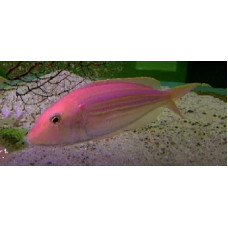Latin name
Nemipterus virgatus
Other name
Yellowlipped threadfin bream
Identification
The body of the golden threadfin bream has a standard length of 3.2-4 times its thickness, and the snout is longer than the diameter of the eye. The front of the upper jaw has 3 or 4 pairs of canine-like teeth. A line drawn from the posterior edge of the suborbital bone reaches the dorsal profile 5-7 rows of scales before the beginning of the dorsal fin. Axillary scales are present.
Features of fish fins
The dorsal fin is supported by 10 spines and 9 soft rays, while the anal fin contains 3 spines and 8 soft rays. The pectoral and pelvic fins are long and extend from the level of the anus to the beginning of the anal fin. The caudal fin is only slightly bifurcated, with the upper lobe extending in the form of a thread.
Fish colouring
The upper body is pink, becoming paler towards the lower body. There is a yellow stripe on the back above the lateral line and 5 other stripes on the flanks below the lateral line. The chest and belly are white. The head is pink with a yellow stripe running from the upper lip to the lower anterior edge of the eye, sometimes there are 2 indistinct yellow stripes on the cheeks. The eye is pink and the upper lip is yellow. The dorsal fin is pale pink with a broad yellow border which has a red edge on the anterior part of the fin and another yellow stripe just above the base of the fin. The anal fin is a translucent pink with a yellow edge and a thin yellow stripe just at the base, extending to the tip of the last soft ray. The caudal fin is pink with a yellow upper edge and is elongated. The pelvic fins are pink with a yellow stripe along the second and third rays and the pectoral fins are translucent and pink.
Distribution
Widespread in the western Pacific, where it occurs in southern Japan, the East China Sea and the northern South China Sea, where it extends from Vietnam to the Taiwan Strait and the Philippines. A separate population occurs in north-western Australia and the Arafura Sea.
Habitat
A tropical marine bottom-dwelling fish found from 1 to 220 m (3 to 722 ft), usually at depths of 18 to 33 m (60 to 110 ft).
Size
The maximum published standard length of this fish is 35 centimetres (14 inches), although a length of 23 centimetres (9.1 inches) is more typical.
Behavior
The golden threadfin bream is a non-migratory species. It inhabits muddy or sandy bottoms. Juveniles are usually found in shallow waters between 18 and 33 metres.
Food and feeding habits
They feed on small fish, crustaceans and cephalopods.
Reproduction
It is a rudimentary hermaphrodite, with males having functioning male sex glands but also retaining some ovarian tissue for life. Spawning in the South China Sea takes place from February to June, peaking from February to April.
Fishing
It is an important commercial fishery in the East China and South China Seas, where it is caught using line, longline and bottom trawls, while juveniles are caught in large numbers as by-catch in shrimp trawls.
Relationship with a person
Harmless.
| Classification | |
| Phylum | Chordata |
| Class | Actinopterygii |
| Squad | Acanthuriformes |
| Family | Nemipteridae |
| Genus | Nemipterus |
| Species | N. virgatus |
| Features | |
| Conservation status | Vulnerable |
| Habitat | Bottom |
| Life span, years | No information |
| Maximum body weight, kg | No information |
| Maximum length, cm | 35 |
| Sailing speed, m/s | No information |
| Threat to people | Edible |
| Way of eating | Predator |
Golden threadfin bream
Tags: golden threadfin bream


